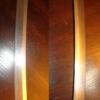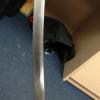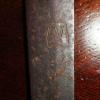First off I would like to express my gratitude to those who provide this site free of charge and those who offer their services to folks like myself. I have received several opinions and learned quite a bit trying to research my sword. I am beginning to realize that the nihonto study is a life long endeavor, governed by educated opinions and exposure to high end swords. For the "new guys" just breaking into the field, ID'ing a sword is a daunting task, and the possibility exists that a concrete undisputed attribution may or may not obtainable. After nearly 2 months of aggressive study and reading the few texts I have, I almost feel like I know less now then when I first held the blade. I must admit I feel over my head. I have received several opinions all similar but none concrete. I purchased the sword on a "sweet heart" deal from an elder comrade of mine. The sword was surrendered to Allied Forces in occupied Japan. I would appreciate any and all attempts to ID the piece. Ideally I would like to know as much as possible about the sword. I would also like you folks to know I have absolutely no commercial interest in the sword and is a piece I would like to pass to my infant son in the very distant future. Zaimei-備前國住助包 Uramei-國次 Nagasa: 53.2 cm Nakago: 14.7 cm Kissaki: 3.2 cm Kasane: 0.6 cm Mihaba: 2.4 cm (center of the blade) Sori: 1.8 cm Thanks all, Nathan |
|||
 |
Nihonto ClubJapanese Sword Information Exchange |
User login |
|
|
Disclaimer: Nihontō Club owners and independent contributors will not be held responsible for any loss, damage or inconvenience caused as a result of any inaccuracy or error within this website. Except where otherwise noted, this page is licensed under a Creative Commons License.
|





Anyone?
Is there anyone here who can or will make comment. Is this a dead board?
Nathan
Hi Nathan, Sorry, I've been
Hi Nathan,
Sorry, I've been busy lately and it's hard to come up with better answers than you already received on NMB. I'll try to look into the books over weekend.
Stan
Thanks!
Stan,
I welcome any and all opinions. I am wondering if it is possible or not to narrow down the exact years of the smith(s), and maybe get a description of the Hamon and other activities that are still visible in this out of polish blade. Maybe if I can get it down to a smith or school, I can compare with like works. Take your time, I am in no rush. I am very grateful for your time and effort.
Nathan
Observations
Hi Nathan,
Few observations about your sword:
Good luck with your research and don't give up - it may take a decade to find out something new about your sword. I would try to answer the following questions:
Either way, don't expect to find a 'great' and ancient sword. It's not.
Regards,
Stan